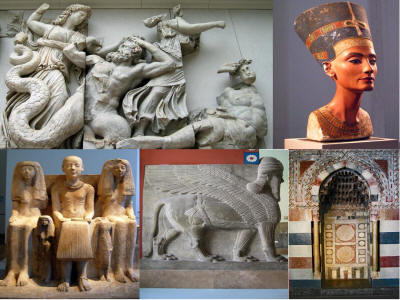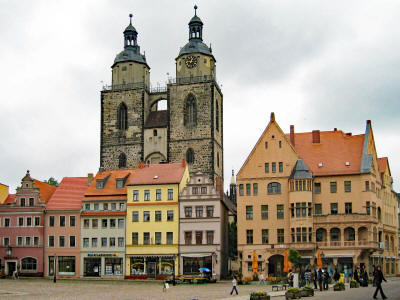|

Berlin, Germany
Since the fall of the Berlin Wall in 1989 and the
reunification of East and West Germany, the former
Soviet-controlled east has experienced a remarkable revival
economically and culturally. Buildings which were destroyed in
WW II have been rebuilt and tourism is rebounding. We enjoyed
seeing the formerly off-limit cities of Berlin, Potsdam,
Dresden, Leipzig and Wittenberg.
|
|

The Reichstag (German Parliament Building) was
totally destroyed in 1945. The West Germans established
Bonn as their capital until 1999. After last meeting here in
1933, Germany's federal parliament returned to the rebuilt
Reichstag in 1999. |

A glass cupola added to the rebuilt Reichstag is
a tourist attraction. Visitors can circle up a ramp while
viewing the rooftops of Berlin and the parliamentary chambers
below.
|
|

Since the fall of the Iron Curtain,
probably no city in Europe has seen more development and change
as Berlin. Re-united East and West Berlin have undergone massive
construction and restoration projects, as seen by the main train
station. |

The Sony Center is one of Berlin's most striking
new buildings. It is surrounded by an entertainment center, and
lies close to the Kulturforum, a complex for art and music.
|
|

While we were there, Germany
was hosting a FIFA championship, and had decorated the city with
soccer-themed installations, here an observation area near the
famous 16th Century Brandenburg Gate.
|

In Alexanderplatz, the
Tiergarten, Gleisdreieck and other public parks and plazas, art
installations are continually added to commemorate and celebrate
events and themes, particularly of friendship and reunification.
|
|

The Memorial to the Murdered Jews of Europe is a 200,000 square
foot area covered with 2711 concrete slabs (stelae), meant to be
a place of symbolism and thoughtful reflection.
|

The Topography of Terror exhibit is located in
the barren bombed out landscape where the Nazi's SS headquarters
stood. Its stark displays outline the history of the Holocaust. |
|

Museum
Island,
a World Heritage Site, is a complex of 6 buildings which include
the Pergamon Museum, The Egyptian Museum, the Altes Museum The
Bode Museum, and Classical and Modern art galleries.
|

The Egyptian and Pergamon
Museums hold impressive collections of antiquities including
items from Egypt, Greece, Assyria, Sumeria, and Babylon. |
|

The Victory Column
was built to commemorate the Prussian victories in
the Danish-Prussian, Franco-Prussian and Austr-Prussian
Wars. It is a tourist attraction mainly for its viewing
platform at the top. |

Kaiser Wilhelm Memorial Church with its
bombed out original tower next to the "modern" 60's
style new tower serves as a reminder of the war and
the emergence of the "New" Germany and a
democratic West Berlin.
|

The Sankt Nicholaus church is an artifact
of the "old" Berlin and the ball-shaped, Swedish-
designed, Communist-built, Fernsehturm is a remnant of
the DDR. |
|
|

Not much is left of the former border crossing, Checkpoint
Charlie, except a small booth, remnants of warning signs, large
images of American and Soviet soldiers and photo ops for selfies.
|

Graffiti on the last remaining stretches of the
Berlin Wall are poignant messages of unification.
|
|

Potsdam is the capital city of Brandenburg,
situated on the Havel river, southwest of Berlin. It is well
known for its historical sites, especially the parks and castles
of Sanssouci, a World Heritage site. |

Sanssouci was the summer home
of Frederick the Great, Prussian king. The complex consists of
several palaces, a landscaped park, greenhouses, the Neptune
Grotto, and stylized structures such as The Chinese House, the
Dragon House and the Antique Temple.
|
|

Wittenberg/ Lutherstadt is the centerpiece of the sites associated with the Protestant Reformation,
including the Wittenberg University and the homes of Luther and
Melanchthon. The 15th Century Stadtkirche towers over the
central Market Square of Wittenberg.
|

Die Schlosskirche (Castle Church) is where Luther
posted his 95 theses in 1517 marking the beginning of the
Reformation. |
|

Buildings representing several centuries of
architecture are found in the old town area of Dresden. A
terrace above the Elbe River provides a breathtaking view of the
skyline.
|

The Semperoper, one of Europe's finest opera
houses where Wagner's work premiered, is lavish and
architecturally stunning. |
|

The recently restored Frauenkirche in Dresden,
Germany's greatest baroque Protestant (Lutheran) church, is a
symbol of reconciliation, as donations for its reconstruction
came mainly from British and American donors.
|

The uniquely painted
Thomaskirche in Leipzig is associated with several
well-known composers such as Wagner, Mendelssohn, and
Bach. |
|

Taking a side-trip to one of
the Nazi concentration camps is a reminder of the horrors of the
Holocaust and a deeply moving experience. |

This mosaic on the wall of the flat roofed,
communist style post office is a reminder of the Soviet
influence in the former cities of East Germany.
|